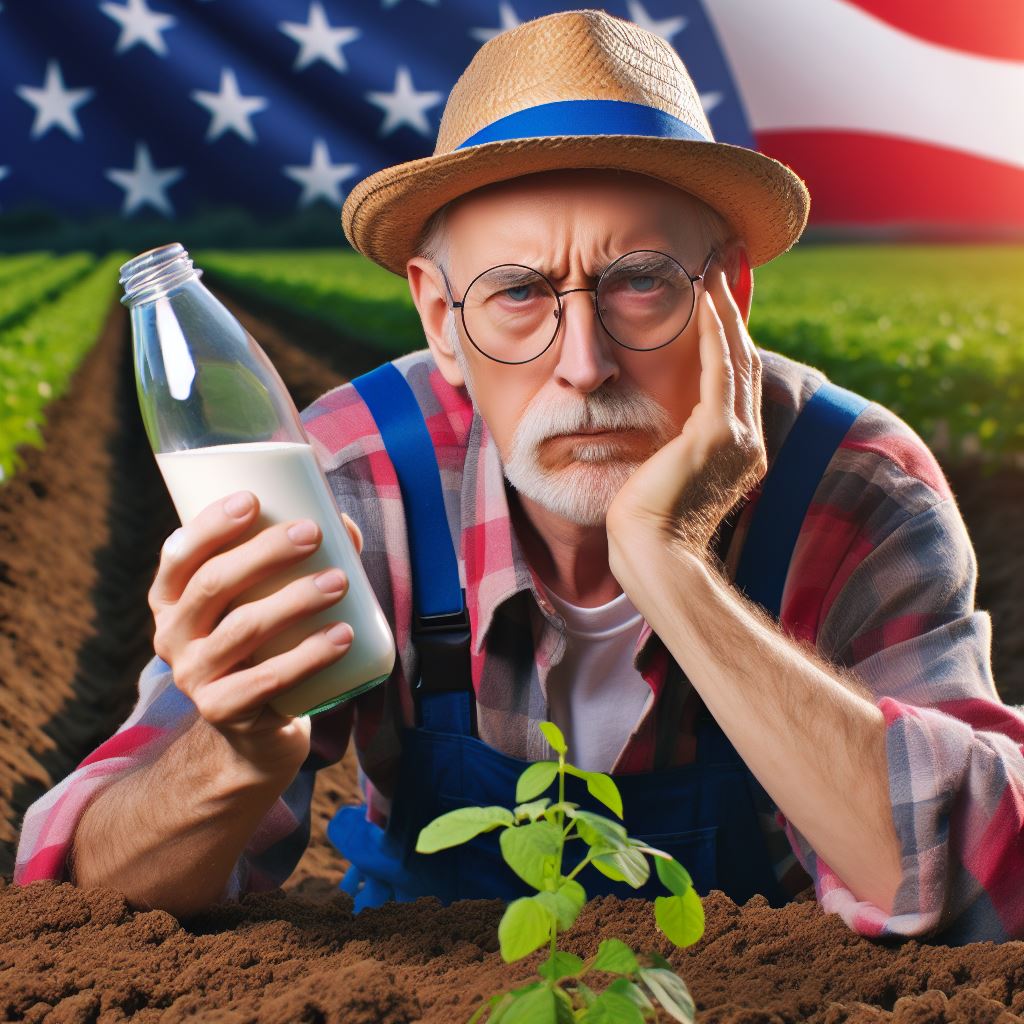Soil Health: Tech’s Role in 2024
Last Updated on January 19, 2024
Introduction
Importance of soil health
The role of tech in soil health is paramount for ensuring long-term sustainable agriculture.
With the increasing global population and the need to feed more people, it is crucial to prioritize the health of our soils.
Healthy soils not only provide essential nutrients to crops but also contribute to ecosystem stability, water filtration, and carbon sequestration.
The role of technology in agriculture
In recent years, technology has revolutionized the agricultural sector, and its role in improving soil health cannot be ignored.
Innovative tools and techniques such as precision farming, remote sensing, and data analytics have significantly contributed to enhancing soil health management practices.
These technologies enable farmers to monitor soil fertility levels, optimize irrigation practices, and detect nutrient deficiencies accurately.
Overview of the purpose of the blog post
The purpose of this blog post is to shed light on the potential role of technology in soil health by 2024.
We will explore the anticipated advancements in agricultural technology and how they can be leveraged to enhance soil health management.
From smart sensors that provide real-time information on soil conditions to robotic platforms that enable targeted applications of fertilizers, technology holds great promise in the future of soil health.
Join us on this exciting journey as we delve into the possibilities and discuss the potential impact of technology on soil health management.
Together, we can explore how technological advancements can contribute to more sustainable agricultural practices, ensuring a healthier future for our soils and the generations to come.
Stay tuned for more insights on the evolving landscape of soil health in the era of technology.
Current state of soil health
Brief explanation of the factors affecting soil health
- Soil erosion: The displacement of topsoil through wind or water can degrade soil quality.
- Chemical fertilizers: Overuse of synthetic fertilizers can lead to nutrient imbalances and soil degradation.
- Pesticides: Excessive pesticide application can harm beneficial soil microorganisms and disrupt the natural ecosystem.
- Industrial pollution: Contamination from industrial activities can introduce toxins into the soil, affecting its health.
- Deforestation: Clearing of forests results in loss of organic matter and decreased soil fertility.
The current state of soil health is a matter of concern as various factors contribute to its decline.
Soil erosion caused by wind and water is a significant threat. It displaces the topsoil, which contains essential nutrients necessary for plant growth.
This leads to reduced soil fertility and productivity.
Chemical fertilizers
Chemical fertilizers, commonly used in modern agriculture, can have detrimental effects on soil health.
Overuse of synthetic fertilizers can cause nutrient imbalances, disturb the delicate microbial ecosystem, and also contaminate water sources.
Pesticides
Pesticides, while essential for pest control, can harm beneficial soil microorganisms.
These microorganisms play a crucial role in maintaining soil health by decomposing organic matter and cycling nutrients.
Excessive pesticide use can disrupt this balance, leading to long-term degradation.
Industrial pollution
Industrial pollution contributes to soil degradation through contamination.
Industries release various pollutants into the environment, including heavy metals, toxins, and chemicals.
These pollutants seep into the soil, affecting its composition and fertility.
Deforestation
Deforestation is another factor that negatively impacts soil health.
Clearing forests eliminates the protective cover provided by trees, exposing soil to erosion.
Additionally, the loss of organic matter from decomposing leaves and roots reduces soil fertility.
The existing challenges in maintaining soil health
- Intensive agricultural practices: Monocropping, excessive tilling, and overuse of agrochemicals degrade soil quality.
- Urbanization: Expanding cities encroach upon arable land, reducing the area available for agriculture.
- Climate change: Extreme weather events, such as droughts and floods, can damage soil structure and nutrient content.
- Land degradation: Degraded soil cannot support diverse vegetation and affects food production and ecosystem stability.
- Lack of awareness: Many people are unaware of the importance of soil health and its impact on overall well-being.
Maintaining soil health faces several challenges, including intensive agricultural practices.
Monocropping, heavy tilling, and the excessive use of agrochemicals degrade soil structure, leading to erosion and nutrient depletion.
Urbanization
Urbanization also poses a threat to soil health.
As cities expand, valuable agricultural land is lost.
This limits the availability of arable land for food production and puts pressure on existing agricultural areas.
Climate change
Climate change exacerbates soil health issues.
Extreme weather events, such as droughts and floods, can damage the structure of the soil, making it less able to retain moisture and essential nutrients for plant growth.
The lack of awareness
The lack of awareness about soil health is a significant obstacle in addressing the problem.
Many people are unaware of the crucial role soil plays in supporting life and the environment.
Educating the public about the importance of soil health is necessary for sustainable land management.
Statistics or data highlighting the decline in soil health
- According to the Food and Agriculture Organization (FAO), 33% of global soils are already degraded.
- The United Nations reports that if soil degradation continues at the current rate, all arable land may disappear within 60 years.
- Studies show that global food production could decline by 30% by 2050 due to soil degradation.
- In the United States, it is estimated that soil erosion causes an annual loss of $44 billion in agricultural productivity.
- Research indicates that soil degradation leads to reduced water filtration capacity and increased pollution runoff.
The alarming statistics emphasize the urgency to address soil health decline.
The FAO reports that approximately one-third of global soils are already degraded.
Furthermore, if the rate of degradation continues, all arable land could disappear within the next six decades.
Studies suggest that global food production could decline significantly due to soil degradation, potentially leading to food security issues.
In the United States alone, soil erosion causes an annual loss of $44 billion in agricultural productivity.
Degraded soil is not only a threat to food production but also contributes to environmental issues.
Reduced water filtration capacity and increased pollution runoff are significant concerns associated with soil degradation.
Overcoming these challenges
To combat these challenges and improve soil health, technological interventions will play a crucial role.
Innovative solutions such as precision agriculture, soil sensors, and data-driven farming techniques can help monitor soil health, optimize resource usage, and promote sustainable practices.
The use of advanced technologies can allow farmers to make informed decisions and minimize negative impacts on soil health.
Additionally, promoting regenerative agriculture practices, such as cover cropping and crop rotation, can help restore soil health and enhance its resilience.
Generally, preserving and improving soil health is essential for sustainable agriculture, food security, and environmental well-being.
Understanding the factors affecting soil health, addressing existing challenges, and utilizing technology to monitor and manage soil quality will be vital for a healthy and prosperous future.
Read: Ag Tech: Improving Crop Yields
Technology’s impact on soil health
Introduction to the role of technology in agriculture
Technology plays a crucial role in modern agriculture, revolutionizing the way farmers approach soil health.
With advancements in various fields, such as precision agriculture, Internet of Things (IoT) applications, and machine learning, technology has become a powerful tool for improving soil health and increasing productivity.
How technology can contribute to soil health
Precision agriculture and soil mapping
Precision agriculture involves the use of advanced sensors and GPS technologies to precisely assess soil conditions and adjust farming practices accordingly.
Soil mapping is a key component of precision agriculture, providing detailed information about soil composition, moisture levels, and nutrient content.
With this data, farmers can optimize fertilizer and irrigation usage, minimizing waste and maximizing crop yields while preserving soil health.
Internet of Things (IoT) applications in soil monitoring
The IoT involves the interconnection of devices and systems, enabling data collection and analysis in real-time.
In the context of soil health, IoT applications allow farmers to monitor and manage soil conditions remotely.
Soil sensors embedded in the ground provide continuous updates on moisture levels, temperature, and nutrient content.
This data can be accessed through mobile devices, allowing farmers to make timely decisions and take proactive measures to protect soil health.
Machine learning for predicting soil health and nutrient requirements
Machine learning algorithms can analyze large datasets and identify patterns that humans may not perceive.
By analyzing soil composition, weather patterns, and crop performance data, machine learning models can predict soil health and nutrient requirements more accurately.
Farmers can then adjust their farming practices accordingly, ensuring optimal nutrient uptake by crops while minimizing the risk of soil degradation.
Examples of successful tech solutions improving soil health
Case studies on how specific technologies have restored or maintained soil health
Carbon sequestration technology
Certain technologies, such as biochar and cover crops, help sequester carbon in the soil, improving soil structure and fertility.
Studies have shown that incorporating biochar and cover crops in farming practices can increase soil organic matter content, water retention, and nutrient availability.
Sensor-based irrigation systems
Advanced irrigation systems equipped with soil moisture sensors can accurately assess the water needs of crops.
This precise water management prevents over- or under-irrigation, minimizing soil erosion, nutrient leaching, and water waste.
Several studies have demonstrated that sensor-based irrigation systems lead to improved soil health and increased crop yields.
Predictive analytics for nutrient management
By leveraging historical data and soil composition analysis, predictive analytics models can forecast nutrient requirements with high accuracy.
With this knowledge, farmers can apply fertilizers in a targeted manner, reducing the risk of nutrient runoff and enhancing soil health.
Essentially, technology’s role in agriculture has significantly impacted soil health by introducing precision agriculture, IoT applications, and machine learning.
These advancements have empowered farmers to make data-driven decisions, optimizing soil conditions, and sustainable productivity.
Successful tech solutions, such as carbon sequestration technology, sensor-based irrigation systems, and predictive analytics, have demonstrated their ability to improve soil health and contribute to a more sustainable agricultural future.
Read: Sustainable Ag Tech: What’s New?

Future trends in technology and soil health
Potential advancements in technology by 2024
In recent years, the intersection of technology and agriculture has gained significant attention.
The incorporation of technology in farming practices has the potential to greatly impact soil health, leading to more sustainable and productive agricultural systems.
As we look ahead to 2024, it is important to explore the potential advancements in technology and how they might influence soil health.
Drones and sensors
Emerging technologies, such as drones and sensors, have already shown promise in the field of soil health.
Drones equipped with multispectral cameras can capture detailed images of agricultural fields, providing valuable information about soil moisture levels, nutrient content, and crop stress.
These technological innovations allow farmers to monitor soil health more efficiently and make data-driven decisions for better soil management practices.
By 2024, it is predicted that these advanced technologies will become more widely available and affordable.
Currently, the cost of deploying such technologies is a barrier for many farmers.
However, as the market grows and various companies enter the sector, the price of these solutions is expected to decrease.
This will increase accessibility for farmers of all scales, allowing them to adopt technology-driven approaches to improve soil health.
Expected benefits of future technology on soil health
Increased efficiency and productivity in farming practices
The benefits of future technology on soil health are numerous.
One of the most significant advantages is increased efficiency and productivity in farming practices.
For example, precision agriculture techniques, enabled by advanced sensors and GPS technology, can help farmers optimize the use of resources such as water, fertilizers, and pesticides.
By targeting specific areas in the field that require intervention, farmers can minimize waste and reduce environmental impact while maximizing crop yields.
Potential to enhance sustainability in agriculture
Furthermore, future technology holds the potential to enhance sustainability in agriculture.
Many advanced solutions aim to reduce the reliance on chemical inputs, focusing instead on holistic approaches to soil health.
By leveraging technological innovations, farmers can implement regenerative agriculture practices, such as cover cropping and crop rotation, promoting soil regeneration and biodiversity.
This shift towards sustainable farming practices is crucial for long-term soil health and environmental stewardship.
Data-driven insights
Data-driven insights are another key advantage of future technology in soil health management.
By continuously monitoring and analyzing soil data collected from sensors and other devices, farmers can gain valuable insights into soil conditions and make informed decisions.
This allows them to optimize soil management strategies, including irrigation scheduling, nutrient application, and pest management.
By tailoring their practices to the specific needs of the soil, farmers can maximize productivity while minimizing negative environmental impacts.
In essence, the future of technology in soil health looks promising.
Emerging technologies and their potential applications offer new opportunities for farmers to improve soil health, increase productivity, and reduce environmental impact.
As advancements continue, it is crucial to ensure the availability and affordability of these technologies for farmers of all scales.
By embracing technology and leveraging data-driven insights, we can create a sustainable and productive future for agriculture and soil health.
Read: Top 5 Trends in Vertical Farming Tech
Challenges and concerns regarding technology’s role in soil health
Identification of potential drawbacks or limitations
- Technology may be expensive and inaccessible for small-scale farmers.
- Reliance on technology could lead to a loss of traditional farming knowledge and practices.
- Technical failures or glitches in systems can disrupt soil health monitoring and management.
- Technology might not fully consider the complexity and variability of soil conditions.
As technology plays an increasingly important role in soil health management, it is essential to acknowledge and address the challenges and concerns that arise.
Identifying potential drawbacks or limitations is essential to prevent undue reliance on technology and potential negative consequences.
Potential cost and accessibility of technology for small-scale farmers
One significant challenge is the potential cost and accessibility of technology for small-scale farmers.
While technological advancements offer immense benefits, their high price can make them unattainable for farmers with limited financial resources.
Thus, efforts should be made to ensure affordability and availability of technology to all farmers, regardless of scale.
Risk of losing traditional farming knowledge
Another concern is the risk of losing traditional farming knowledge and practices due to an overreliance on technology.
It is crucial to strike a balance between technological solutions and traditional wisdom to ensure a holistic approach to soil health.
Training programs must accompany the adoption of technology to equip farmers with the necessary skills to leverage technology effectively while preserving traditional practices.
Technical failures or glitches in system performance
Technical failures or glitches in system performance pose a potential risk to soil health management.
Technology is not infallible and can experience malfunctions or interruptions, which could disrupt the accuracy and reliability of soil health monitoring and management.
Regular maintenance, technical support, and backup plans must be in place to address any potential technical failures promptly.
Reliance on pre-programmed algorithms and models
One limitation of technology is its reliance on pre-programmed algorithms and models, which might not consider the intricate complexity and variability of soil conditions.
Soil health depends on various factors, including microorganisms, organic matter, and climatic conditions.
Technology should continuously evolve to include a comprehensive understanding of these elements to provide accurate assessments and recommendations.
The need for proper implementation and regulation
- Technology should be accompanied by comprehensive training and support to ensure effective use.
- Regulations must be established to prevent misuse of technology and protect soil health.
- Government and industry collaboration is crucial to create standardized guidelines and best practices.
- Clear policies should address potential conflicts arising from the adoption of technology in soil health.
Proper implementation and regulation of technology are paramount to ensure its benefits are realized while mitigating potential adverse effects.
Adequate training and support should accompany the introduction of technology to enhance farmers’ understanding and utilization of advanced tools.
Regulatory bodies must establish guidelines to prevent misuse of technology and safeguard soil health.
Collaboration between government agencies and industry stakeholders is crucial in standardizing technology guidelines and best practices.
By working together, they can define clear policies that address potential conflicts that may arise from the integration of technology into soil health management.
Including diverse perspectives in the regulatory process will ensure the interests of all stakeholders are considered.
Addressing concerns related to data privacy and cybersecurity
- Data collected by technology must adhere to strict privacy protocols.
- Proper encryption and safeguards should be in place to protect data from cyber threats and breaches.
- Legal frameworks need to be established to ensure the secure storage and transfer of soil health data.
- Farmers should have control over their data and be aware of how it is used and shared.
Data privacy and cybersecurity are additional concerns regarding the use of technology in soil health.
As technology collects and processes vast amounts of data, strict privacy protocols must be in place to protect farmers’ information.
Proper encryption and safeguards are necessary to fend off potential cyber threats and maintain data integrity.
Legal frameworks should be established to ensure the secure storage and transfer of soil health data, providing farmers with greater control over their information and awareness of its use and sharing.
In a nutshell, technology’s role in soil health management brings numerous benefits, but it also presents challenges and concerns that need to be addressed for its successful integration.
By identifying potential limitations, emphasizing proper implementation and regulation, and addressing data privacy and cybersecurity concerns, we can ensure technology enhances soil health sustainably and responsibly.
Read: Soil Health Monitoring: New Tech Trends
Conclusion
Recap of the importance of soil health
Soil health is essential for sustainable agriculture and food security.
Healthy soils provide nutrients for plant growth, help filter and regulate water flow, support biodiversity, and regulate greenhouse gases.
Maintaining and improving soil health should be a top priority.
The role and potential of technology in soil health by 2024
Exciting technological advancements provide new opportunities to monitor, measure, and manage soil health in 2024 and beyond.
Precision agriculture tools like sensors, satellite imagery, and data analytics allow for targeted application of inputs and practices.
DNA sequencing identifies soil microbiome health.
Artificial intelligence models help predict soil changes.
Adoption of these technologies will increase efficiency, productivity, and soil protection.
Encouragement for farmers to embrace technological advancements for sustainable agriculture
Farmers have an important role to play in embracing new technologies for healthy soils.
Working with experts in agriculture technology will ensure tools are tailored for individual needs.
Building knowledge and skills in using cutting-edge systems prepares farmers for success.
With technology partnerships, farmers can lead the charge in sustainable agriculture.
Healthy soils start with farmers supported by the latest innovations.
The future depends on healthy soils.
Technological solutions in 2024 and beyond provide farmers new ways to understand, nurture, and heal the ground.
By working together, we can ensure thriving agriculture and soils for generations to come.
The time for action is now.


